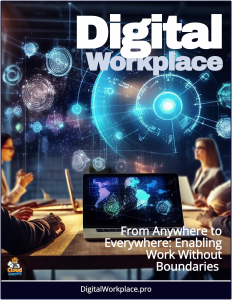 The workplace has undergone a profound transformation, evolving from the traditional office into a dynamic, boundaryless digital ecosystem that redefines how we work.
The workplace has undergone a profound transformation, evolving from the traditional office into a dynamic, boundaryless digital ecosystem that redefines how we work.
No longer confined to physical spaces, the digital workplace empowers individuals and organizations to thrive in a connected world, where work can happen anywhere and everywhere.
This shift is not merely technological—it’s a cultural and operational revolution that prioritizes flexibility, collaboration, and innovation. By enabling seamless work across geographies and time zones, the digital workplace is reshaping the future of productivity.
The Future of Work
The digital workplace emerged as organizations adapted to rapid technological advancements and evolving workforce expectations. The global pivot to remote work, catalyzed by the events of 2020, demonstrated that productivity could flourish beyond office walls. Today, the digital workplace is a comprehensive ecosystem integrating technology, processes, and people to create seamless work experiences.
Cloud computing, collaboration platforms like Microsoft Teams and Slack, and advanced cybersecurity solutions have erased geographical constraints, enabling employees to access tools and data from any location.
Artificial intelligence and automation further amplify productivity by streamlining repetitive tasks and delivering actionable insights. Far from a passing trend, the digital workplace has become essential for organizations striving to remain competitive in a globalized economy.
At its core, the digital workplace relies on robust, scalable technology as its foundation. Cloud-based platforms ensure employees can access applications and data from any device, whether they’re working from a home office or a café halfway across the world. Tools like Zoom, Asana, and Google Workspace facilitate real-time collaboration, allowing teams to work together effortlessly across continents.
AI-powered assistants, such as Grok, created by xAI, provide instant support and answers, enhancing decision-making. High-speed internet, secure VPNs, and advanced cybersecurity protocols are critical to ensuring safe and efficient work, no matter the location. However, technology alone is not enough—success hinges on fostering a people-centric culture that prioritizes trust, inclusivity, and empowerment.
This means focusing on outcomes rather than hours worked, equipping employees with the skills to navigate digital tools, and promoting work-life balance through flexible schedules and wellness initiatives.
Global Collaboration Suite
Collaboration lies at the heart of the digital workplace, breaking down silos and fostering innovation across distances. Tools enabling synchronous and asynchronous communication—such as shared digital whiteboards, project management software, and instant messaging—allow teams to work seamlessly, regardless of time zones.
A designer in Tokyo can iterate on a project with a developer in São Paulo in real time, ensuring creativity flows without boundaries. Yet, this boundaryless environment demands robust security and governance. With employees accessing sensitive data from diverse locations and devices, organizations must implement multi-factor authentication, end-to-end encryption, and regular security training.
Governance frameworks ensure compliance with regulations like GDPR or CCPA, while balancing employee privacy and trust, creating a secure foundation for distributed work.
The benefits of a boundaryless digital workplace are transformative. Organizations can tap into global talent pools, hiring the best candidates regardless of location, which enriches diversity and perspectives. Employees gain flexibility to work during their most productive hours, boosting efficiency and job satisfaction.
Cost savings are significant, as companies reduce expenses on physical offices and utilities, while employees save on commuting costs. A distributed workforce also enhances resilience, enabling organizations to adapt to disruptions like pandemics or local crises. Most importantly, the flexibility and autonomy of the digital workplace foster higher employee satisfaction, reducing turnover and building loyalty.
Despite its promise, the digital workplace presents challenges that require proactive solutions. Digital overload can lead to burnout from constant connectivity, but organizations can counter this by encouraging boundaries, such as designated offline hours or “no-meeting” days.
Empowering Remote Teams
Remote teams may face collaboration gaps due to miscommunication, which can be addressed by investing in intuitive tools and regular virtual team-building activities.
Security risks are heightened in a distributed environment, but zero-trust security models and ongoing employee training on phishing and data protection can mitigate vulnerabilities. A cultural disconnect is another risk, as remote work can weaken organizational cohesion. Virtual communities, regular check-ins, and recognition programs can help maintain a strong, inclusive culture.
To build a future-ready digital workplace, organizations must act strategically. Investing in scalable, integrated technology is critical to support growth and streamline operations. Upskilling the workforce through training on digital tools, cybersecurity, and remote collaboration empowers employees to succeed.
Designing policies that prioritize flexibility allows employees to tailor their work environment to their needs, while ensuring inclusivity ensures equal access to opportunities for all. Regularly measuring productivity, engagement, and tool adoption through analytics, combined with employee feedback, enables organizations to refine the digital workplace experience continuously.
The digital workplace is not a static achievement but an ongoing journey toward a future where work knows no boundaries. Emerging technologies like the metaverse, augmented reality, and advanced AI promise to further blur the lines between physical and digital workspaces, creating immersive environments for collaboration and innovation.
Conclusion: The Call to Action
Organizations that embrace the digital workplace today will lead tomorrow, unlocking a world where work is not confined by walls, time zones, or limitations. By prioritizing technology, culture, collaboration, and security, they can create an environment where every individual has the tools and freedom to thrive, transforming “anywhere” into “everywhere.”
Begin with small, intentional steps to assess your organization’s digital readiness. Invest in the right tools, empower your people, and build a culture that embraces flexibility and inclusivity. The digital workplace is here—let’s shape a future where work knows no boundaries.



